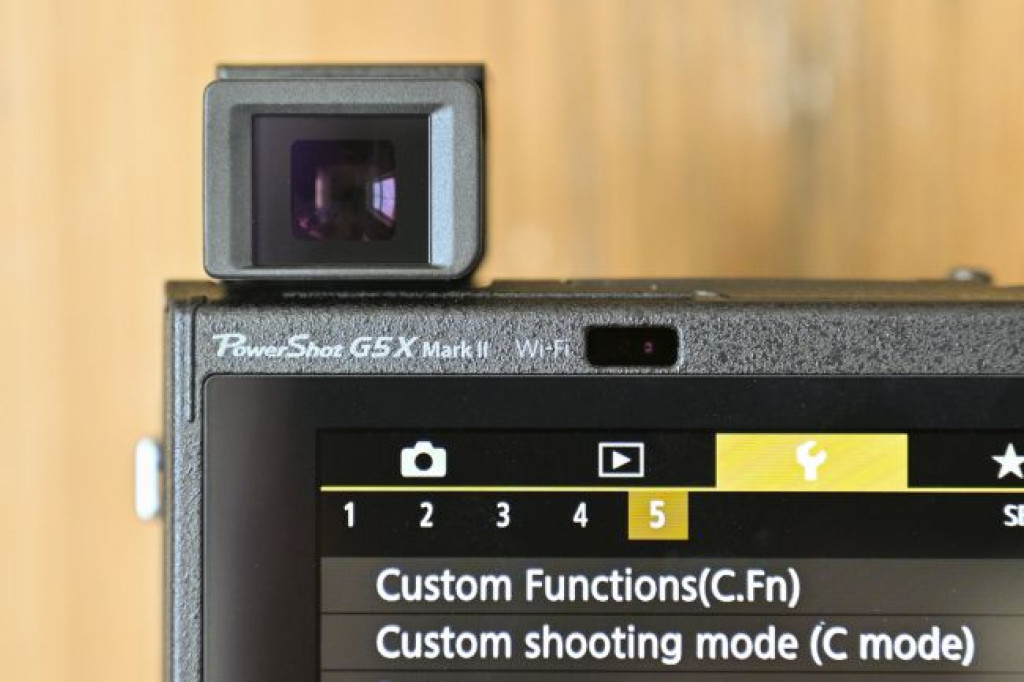
EARLY VERDICT
The PowerShot G5 X Mark II is quite a different proposition to the existing G5 X, and with its new EVF it’s arguably the closest rival to Sony’s RX100 models to date. It feels great in the hands and is responsive in use, and the EOS-style interface makes for great operation. If image and video quality hold up, this will no doubt be a smash.
FOR
- Feels very well put together
- Responsive and fast AF
- EOS-style menu system
- Grip makes for excellent handling
AGAINST
- EVF needs to be pulled back before use
- Lens control ring feels somewhat hollow
- Expensive next to Sony RX100 III and IV
Although rumors of an update to the PowerShot G7 X Mark II have been far stronger than anything suggesting a follow-up to the G5 X, the G5 X Mark II is arguably a more intriguing release than its Canon PowerShot G7 X Mark III launch partner.
Canon has made some key changes both inside and out to create quite a different camera to the model it follows. It’s updated the sensor and lens, and revised the body to produce a model that feels quite different to the G5 X in the hand. We spent some time with the G5 X Mark II to find out more.
Features
- 20MP stacked 1-inch CMOS sensor
- New lens: 24-120mm f/1.8-2.8 (35mm equiv.)
- 4K video recording to 30 (no crop)

The PowerShot G5 X Mark II arrives with a 20.1MP stacked CMOS sensor, and this mirrors those inside many other enthusiast compacts by being a 1-inch sensor.
In front of it sits a new lens that offers a 35mm equivalent range of 24-120mm, which is a touch longer than the lens inside the G5 X, and this has been furnished with a four-stop, five-axis Image Stabilizer to help keep images crisp and videos steady.
The model also receives the latest DIGIC 8 processing engine, together with a 30fps Raw Burst mode and 4K video recording without a crop. With the further bonus of a flip-up LCD screen, the model is likely to appeal both to videographers, and to enthusiasts who imagine they may capture the odd selfie or group shot.
Design
- RX100-esque pop-up EVF
- Lens control ring
- Tilting LCD screen can face the front
Canon has changed the design of the G5 X Mark II so significantly from the previous G5 X that you wonder why it didn’t ago for a different name. In place of the G5 X’s DSLR-like design and chunky grip, here we get a more conventional compact design with a flat top.
The other big change is the electronic viewfinder, which now hides in the top plate when not in use. This is released through a catch at the side of the camera, and needs to be pulled back into position before use (as shown below).

Sound familiar? Sony used this same design for three of its RX100 compacts, although its most recent RX100 Mark VI improved on this, with the EVF being ready for use as soon as it’s released from the top plate, and capable of being pushed down in a single action too. This isn’t the case here, although it’s hardly a deal-breaker – and the G5 X Mark II is quite a bit cheaper than the RX100 Mark VI.
It’s not just the design of the top plate that’s changed, but the controls available on it too. Whereas the original PowerShot G5 X has a mode dial on one side of the top plate and an exposure compensation dial on the other, the former is now stacked on top of the latter (below), much like on the PowerShot G7 X Mark II and Mark III models.

Implementing this arrangement effectively is always something of a balancing act – it needs to provide enough physical control to make immediate option adjustment effortless, but not make these too fiddly, stiff, or likely to be accidentally knocked out of place.
But Canon seems to have done well here, with the stacked design making good use of space, and the dials turning without much faff. We’ll have to wait until we get a full review sample to see just how well these stay put in day-to-day use, though.
Once again, we find a control ring around the lens, which can be used to adjust key settings. This moves well, although it feels somewhat light and hollow when turned.
This is in contrast to the rest of the body, which is built very well and gives the camera the premium feel expected of a camera with its price tag. The attention to detail is impressive, and the liberal use of rubber provides a secure hold, something that’s further helped by the sculpted grip around the front and defined thumb rest on the back.
Performance
- Very responsive in use
- EOS-style menu system
- Face detection fast and accurate
Initial impressions of the Canon PowerShot G5 X Mark II’s performance are certainly positive. The camera starts up quickly and is generally very responsive in use, be that when you’re adjusting settings, using the touchscreen or anything else.
It’s also great to be able to navigate the EOS-style menu system to adjust settings. Naturally this isn’t quite as complete as those on the likes of the EOS R or EOS 5D Mark IV, but it’s a good step up on the previous interface.
The viewfinder is nice and clear, and it springs to life very quickly as the eye is raised towards it. Somewhat unusually, the sensor for this is located a little away from the finder itself, on the top of the LCD screen, but it works very effectively.
The focusing system, which is a standard contrast-detect AF setup rather than one with a phase-detect AF pixels built into the sensor, also showed itself to be nice and speedy in the conditions in which it was tested. Its Face Detection system also picked out faces that were relatively small in the frame very quickly, even when the subject wasn’t directly facing the camera.
We’ll have to wait to try a full review sample before getting a clear idea of image quality, but hopefully with a new stacked sensor – potentially one that’s similar to those inside Sony’s models – and a new optic, we should expect to see an improvement on the G5 X.
Early verdict

While some of Canon’s previous models gave the impression that Canon wasn’t particularly looking to challenge what some rivals were doing, the revised design of the PowerShot G5 X Mark II shows the company to be going after the Sony RX100 audience more seriously than before.
As further proof of this, the company has stated that it will maintain the existing PowerShot G5 X and PowerShot G7 X Mark II models, rather than replace them with these latest versions. By doing so, it will give users a choice of a newer pricier product and an older one at a more accessible price, which is exactly what Sony has long done with its RX100 line (and many other, such as the mirrorless A6000 series and A7 models); you do wonder why this strategy hasn’t been adopted by Canon sooner.
With a design that’s so similar to the new G7 X Mark III, we question the logic of having two models that not only look the same but have similar innards, although Canon knows better than anyone else how the market has responded to its existing selection, and has no doubt made the adjustments it thinks are necessary to satisfy its audience.
Quite whether it’s able to win over those that already have six Sony RX100 models to choose from, all at various prices, in addition to the likes of the Panasonic’s excellent LX15 and Ricoh’s latest GR III, remains to be seen.
Source: techradar.com









































